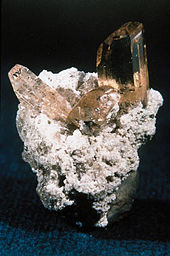Topaz
| Topaz | |
|---|---|
 |
|
| a group of topaz crystals on matrix | |
| General | |
| Category | Silicate mineral |
| Chemical formula | Al2SiO4(F,OH)2 |
| Identification | |
| Color | Clear (if no impurities), blue, brown, orange, gray, yellow, green, pink and reddish pink. |
| Crystal system | orthorhombic |
| Cleavage | [001] Perfect |
| Fracture | conchoidal |
| Mohs Scale hardness | 8 |
| Luster | Vitreous |
| Refractive index | nα = 1.606 - 1.629 nβ = 1.609 - 1.631 nγ = 1.616 - 1.638 |
| Optical Properties | Biaxial (+) |
| Birefringence | δ = 0.010 |
| Pleochroism | Weak in thick sections |
| Streak | White |
| Specific gravity | 3.49 - 3.57 |
| Diaphaneity | Transparent |
| Other Characteristics | Fluorescent, short UV=golden yellow, long UV=cream |
| References | [1][2][3] |
Topaz is a silicate mineral of aluminium and fluorine with the chemical formula Al2SiO4(F,OH)2. It is the birthstone of the month November. It crystallizes in the orthorhombic group and its crystals are mostly prismatic terminated by pyramidal and other faces, the basal pinacoid often being present. It has an easy and perfect basal cleavage, meaning that gemstones or other fine specimens have to be handled with care to avoid developing cleavage flaws. The fracture is conchoidal to uneven. Topaz has a hardness of 8, a specific gravity of 3.4–3.6, and a vitreous luster.
Contents |
Color and varieties
Pure topaz is transparent but is usually tinted by impurities; typical topaz is wine or straw-yellow. They may be made white, gray, green, blue, pink or reddish-yellow and transparent or translucent.
Yellow topaz is the traditional November birthstone, the symbol of friendship, and the state gemstone for the US State of Utah.
Blue topaz is the Texas state gemstone, often cut with the Lone Star cut - the Texas state gemstone cut showing a star in the heart of the gem.[4] The Texas Natural Science Center exhibits a 1778 carat blue topaz found in a Brazilian mine.[5]
Mystic topaz is colorless topaz with a thin film/coating giving it the desired rainbow effect, and is not a naturally occurring topaz.[6]
Localities and occurrence
Topaz is commonly associated with silicic igneous rocks of the granite and rhyolite type. It typically crystallizes in granitic pegmatites or in vapor cavities in rhyolite lava flows like those at Topaz Mountain in western Utah. It may be found with fluorite and cassiterite. It can be found in the Ural and Ilmen mountains, Afghanistan, Sri Lanka, Czech Republic, Germany, Norway, Pakistan, Italy, Sweden, Japan, Brazil, Mexico, Flinders Island and the United States.
Some clear topaz crystals from Brazilian pegmatites can reach boulder size and weigh hundreds of pounds. Crystals of this size may be seen in museum collections. The famous Braganza diamond is in most likelihood a topaz. The Topaz of Aurungzebe, observed by Jean Baptiste Tavernier measured 157.75 carats.[7]
Colorless and light-blue varieties of topaz are found in Precambrian granite in Mason County, Texas[8] within the Llano Uplift. There is no commercial mining of topaz in that area.[9]
Etymology and historical and mythical usage
The name "Topaz" is derived from the Greek Τοπάζιος (Τοpáziοs), the author of one of the first systematic treatises on minerals and gemstones dedicated two chapters on the topic in 1652.[10] In the Middle Ages the name Topaz was used to refer to any yellow gemstone, but now the name is only properly applied to the silicate described above.
Many modern English translations of the Bible, including the King James Version mention Topaz in Exodus 28:17 in reference to a stone in the Hoshen: "And thou shalt set in it settings of stones, even four rows of stones: the first row shall be a sardius, a topaz, and a carbuncle: this shall be the first row."
However, since these translations as topaz all derive from the Septuagint translation topazi[os], which as mentioned above referred to a yellow stone that wasn't Topaz, probably chrysolite, it should be borne in mind that Topaz is not meant here.[11] The masoretic text (the Hebrew on which most modern protestant bible translations of the Old Testament are based) has pitdah as the gem the stone is made from; pitdah is of unknown meaning, though scholars think it is related to an Assyrian word meaning flashed. There is a wide range of views among traditional sources about which tribe of the Israelites the stone refers to.
References
- Hurlbut, Cornelius S.; Klein, Cornelis, 1985, Manual of Mineralogy, 20th ed., ISBN 0-471-80580-
- ↑ http://rruff.geo.arizona.edu/doclib/hom/topaz.pdf Handbook of Mineralogy
- ↑ http://www.mindat.org/show.php?id=3996&ld=1&pho= Mindat
- ↑ http://webmineral.com/data/Topaz.shtml Webmineral
- ↑ Texas State Library & Archives Commission Web site
- ↑ Blue Topaz - Natural Wonders: Treasures of the Texas Natural Science Center
- ↑ Mystic Topaz, Consumer Information
- ↑ Famous and Notheworthy Topazes Rao Bahadur, A Handbook of Precious Stones, Geological Survey of India
- ↑ Handbook of Texas Online - Mineral Resources and Mining
- ↑ Mason, Texas Chamber of Commerce Web site
- ↑ A Lapidary or History of Gemstones, University of Cambridge, 1652
- ↑ see for extensive discussion Oliver Farrington, Gems and Gem Minerals, Chicago, 1903. Farrington was curator of Natural History Museum in Chicago.
External links
- Pink Topaz, Biblical Topaz References a few dozen full text historical references on Topaz
- Mineral galleries
|
|||||||||||||||||